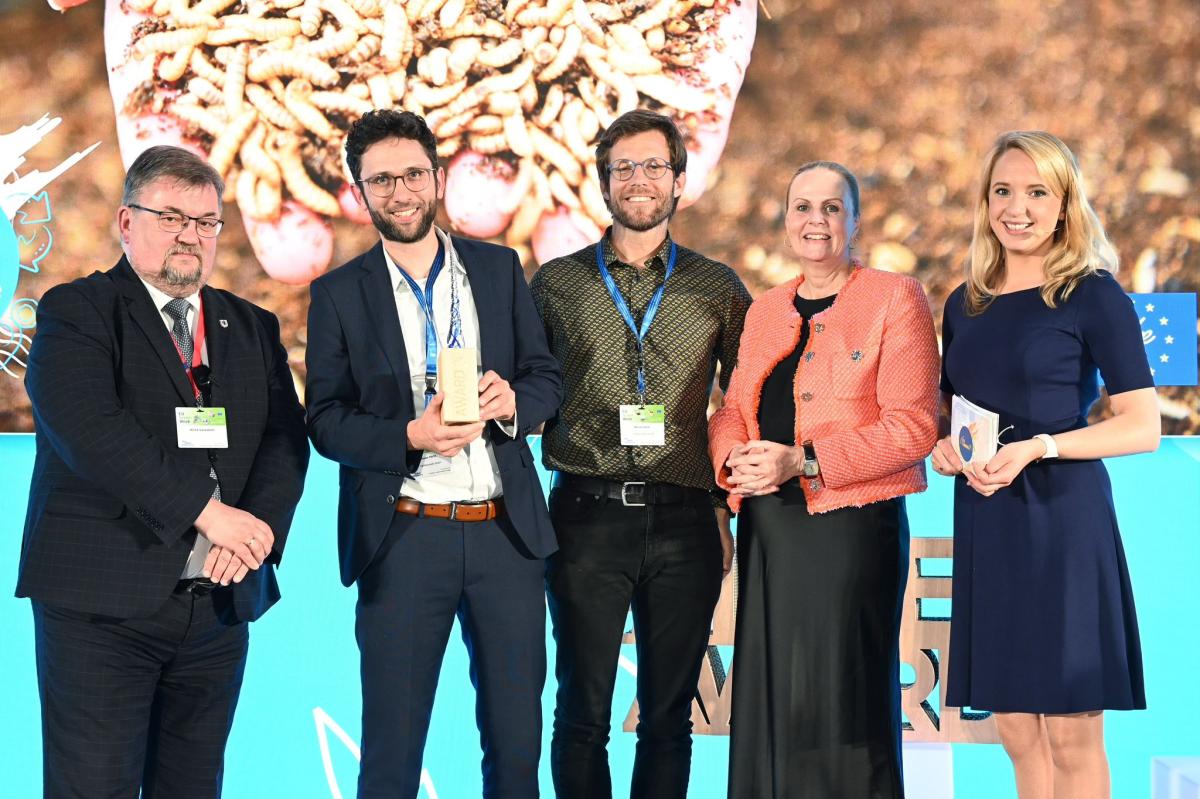LIFE Awards 2024 Winners: spotlight on the Circular Economy


The Demand for Animal Protein and the Sustainable Development Goals

The demand for animal protein – mainly driven by rising populations and rapidly increasing livestock production – will be an astonishing 75 percent higher in 2050 compared to the early 21st century. This poses significant challenges for the climate, nature, water, and the environment (LIFE Waste2Protein).
The Sustainable Development Goals
- Goal 2: Zero Hunger
- Goal 6: Clean Water and Sanitation
- Goal 13: Climate Action
- Goal 15: Life on Land
Seventy percent of the world’s farmland is used to grow feed for animals, highlighting the need for sustainable solutions to address this challenge. One such solution is the LIFE Waste2Protein project, which was recently awarded the 2024 LIFE Award for Circular Economy. The project, led by madebymade GmbH, operates across Italy, France, and Germany and aims to produce insect protein from organic residues as an alternative to soy and fish meal. This approach not only reduces greenhouse gas emissions and protects biodiversity but also contributes to achieving the Sustainable Development Goals.
The LIFE Awards and the Circular Economy
- The LIFE Awards are an annual celebration of successful projects implemented under the EU LIFE Programme.
- Finalists and winners are judged based on their contribution to environmental, economic, and social improvements, innovation and transferability, relevance to policy, and cost-effectiveness.
- The 2024 LIFE Award for Circular Economy was presented to the LIFE Waste2Protein project for its achievements in creating a sustainable and environmentally friendly alternative to traditional livestock feed.
The four-year LIFE Waste2Protein project concluded last year and achieved impressive results. These include the establishment of Europe’s first insect farm capable of processing 20,000 kilograms of biowaste per day into high-nutrient livestock feed, the creation of the largest bioconversion facility, and a significant reduction in carbon footprint compared to fish meal and soybean meal.
Director General Florika Fink-Hooijer of DG Environment emphasized the importance of the LIFE Awards in recognizing projects that have the potential for large-scale change. She commended the passion and commitment demonstrated by participants in LIFE projects and their ability to turn ideas into tangible solutions with a significant impact.
Other Notable Projects
In addition to the LIFE Waste2Protein project, two other projects were recognized in the Circular Economy category:
- LIFE GreenShoes4All: This project designed innovative, environmentally-friendly shoes to reduce waste and CO2 emissions in the footwear industry.
- LIFE Planet Farms: This ground-breaking project developed an air treatment, hydroponic irrigation, and automated system for the EU’s first industrial-scale vertical farm.
The selection of a single winner was a challenging task due to the creative and forward-thinking nature of these projects. Jacek Gajewski, Alternate member of the Kujawsko-Pomorskie Regional Assembly at the European Committee of the Regions, acknowledged the difficulty in choosing a winner and praised the innovative approaches taken by all the finalists.
The LIFE Programme and Funding Opportunities
The LIFE Programme is the EU’s funding instrument for the environment and climate action. Since 1992, it has co-financed over 6,000 projects across the EU and other countries. Applications are currently open for €571 million worth of funding for LIFE projects in 2024, providing opportunities for further innovation and sustainability initiatives.
SDGs, Targets, and Indicators in the Article
1. Which SDGs are addressed or connected to the issues highlighted in the article?
- SDG 2: Zero Hunger
- SDG 6: Clean Water and Sanitation
- SDG 7: Affordable and Clean Energy
- SDG 12: Responsible Consumption and Production
- SDG 13: Climate Action
- SDG 15: Life on Land
2. What specific targets under those SDGs can be identified based on the article’s content?
- SDG 2.4: By 2030, ensure sustainable food production systems and implement resilient agricultural practices that increase productivity and production, that help maintain ecosystems, that strengthen capacity for adaptation to climate change, extreme weather, drought, flooding, and other disasters, and that progressively improve land and soil quality.
- SDG 6.4: By 2030, substantially increase water-use efficiency across all sectors and ensure sustainable withdrawals and supply of freshwater to address water scarcity and substantially reduce the number of people suffering from water scarcity.
- SDG 7.2: By 2030, increase substantially the share of renewable energy in the global energy mix.
- SDG 12.3: By 2030, halve per capita global food waste at the retail and consumer levels and reduce food losses along production and supply chains, including post-harvest losses.
- SDG 13.2: Integrate climate change measures into national policies, strategies, and planning.
- SDG 15.5: Take urgent and significant action to reduce the degradation of natural habitats, halt the loss of biodiversity, and protect and prevent the extinction of threatened species.
3. Are there any indicators mentioned or implied in the article that can be used to measure progress towards the identified targets?
- Indicator for SDG 2.4: Percentage increase in sustainable food production systems and resilient agricultural practices.
- Indicator for SDG 6.4: Water-use efficiency across sectors and the number of people suffering from water scarcity.
- Indicator for SDG 7.2: Share of renewable energy in the global energy mix.
- Indicator for SDG 12.3: Per capita global food waste at the retail and consumer levels and food losses along production and supply chains.
- Indicator for SDG 13.2: Integration of climate change measures into national policies, strategies, and planning.
- Indicator for SDG 15.5: Reduction in the degradation of natural habitats, loss of biodiversity, and protection of threatened species.
Table: SDGs, Targets, and Indicators
| SDGs | Targets | Indicators |
|---|---|---|
| SDG 2: Zero Hunger | 2.4: By 2030, ensure sustainable food production systems and implement resilient agricultural practices that increase productivity and production, that help maintain ecosystems, that strengthen capacity for adaptation to climate change, extreme weather, drought, flooding, and other disasters, and that progressively improve land and soil quality. | Percentage increase in sustainable food production systems and resilient agricultural practices. |
| SDG 6: Clean Water and Sanitation | 6.4: By 2030, substantially increase water-use efficiency across all sectors and ensure sustainable withdrawals and supply of freshwater to address water scarcity and substantially reduce the number of people suffering from water scarcity. | Water-use efficiency across sectors and the number of people suffering from water scarcity. |
| SDG 7: Affordable and Clean Energy | 7.2: By 2030, increase substantially the share of renewable energy in the global energy mix. | Share of renewable energy in the global energy mix. |
| SDG 12: Responsible Consumption and Production | 12.3: By 2030, halve per capita global food waste at the retail and consumer levels and reduce food losses along production and supply chains, including post-harvest losses. | Per capita global food waste at the retail and consumer levels and food losses along production and supply chains. |
| SDG 13: Climate Action | 13.2: Integrate climate change measures into national policies, strategies, and planning. | Integration of climate change measures into national policies, strategies, and planning. |
| SDG 15: Life on Land | 15.5: Take urgent and significant action to reduce the degradation of natural habitats, halt the loss of biodiversity, and protect and prevent the extinction of threatened species. | Reduction in the degradation of natural habitats, loss of biodiversity, and protection of threatened species. |
Source: cinea.ec.europa.eu








